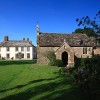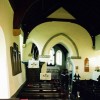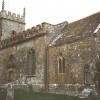Visitors to Dorset’s History Centre in Dorchester, formerly the Record Office, can see and consult a history of Dorset in four massive volumes. The pages of these gargantuan tomes represent the life work of a remarkable clerical historian who died over 230 years ago, and a challenging project with a chequered history quite as intriguing as the life of its author: the Reverend John Hutchins. His four-volume work is the definitive archive for the county of his day, yet this clergyman’s monumental task suffered setbacks and came close to not reaching the presses at all.
On Sunday, July 25th 1762, 64-year-old John Hutchins, then rector of Holy Trinity Church in Wareham, was away conducting a service at Swyre Church near Bridport when fire broke out in one of Wareham’s many timber buildings. Fanned by wind, the fire rapidly engulfed a large area of the town including the rectory, where Mrs Hutchins was at home. At what must have been great personal risk the rector’s wife left and re-entered the blazing building more than once to salvage whatever she could of her husband’s transcripts and notes – including those for the developing history of Dorset – each time emerging with armfuls of the irreplaceable documents. Not all of the papers could be salvaged but enough were saved to enable Hutchins to continue his work on the project. But for this courageous act of a devoted wife, Hutchins history of Dorset may never have seen completion. Holy Trinity’s Rectory, insured for £300, was the fourth building to catch alight, but the fire left 132 other buildings either badly damaged or reduced to charred embers.
Hutchins attention and interest were first turned to studying the history of Dorset through the unusual channel of a request for a piece of genealogical research. In the mid 1730’s the then Lord of the Manor of Milton Abbas, Jacob Bancks, asked Hutchins if he would conduct enquiries into the history of the Tregonwells – the family of Banck’s mother – on his behalf. This soon led to Hutchins examining collections of earlier documentary material about Dorset. Bancks then encouraged the minister to start collating and writing a comprehensive historical treatise on the county.
In 1736 another noted antiquarian and historian of the day, Brown Willis of Blandford, returned to Dorset and further persuaded Hutchins to undertake the task of writing the county’s history. Three years later Willis devised a six-point questionnaire, together with an appeal for help, which he then distributed throughout the county. Thus John Hutchins came to begin his great undertaking. But what manner of man was this who’s unflagging motivation put his county down on paper for all to consult in the centuries to come?
John Hutchins was born in Bradford Peverill on the 21st of September 1698, the son of the Revd. Richard Hutchins, then rector of All Saints in Dorchester. Richard’s wife, John’s mother, died when John was only eight years old. When older, John was sent to be educated at Dorchester Grammar School, from where he went up to Oxford to study towards taking holy orders, graduating with a BA in 1722.
Hutchins first clerical position was as curate at Milton Abbas, and it was likely during this time that Jacob Bancks was responsible for his preferment to his next ministry as rector of Swyre by 1729. Again, through Banck’s influence, Hutchins secured the living at Melcombe Horsey, where by this time his writing of the history of Dorset was already underway, though the move to Melcombe proved to be a setback in his studies. He did however marry Anne Stephens, daughter of the rector of Pimperne, while at Melcombe. John and Anne had just one child, a daughter they baptised Anne Martha.
The Hutchins last and most enduring move was to Wareham, when John was appointed rector of Holy Trinity (with St. Martins and St Mary’s) in 1744. It was said of him that he was “a sound divine, rather than an eminent, preacher.” Little is known of his parochial activities before coming to Wareham but he seems to have been a conscientious parish priest. However, Hutchins was not without his difficulties during the Wareham years. The town was a stronghold of non-conformism, and furthermore one of Hutchins curates had to be committed to an asylum. Then with Hutchins in absentia came the day of the great fire and his wife’s Anne’s heroic act of salvage.
However in 1761, a year before the fire but when the History has been in writing for about 25 years, Hutchins received a generous subscription enabling him to research archives in London and Oxford. With occasional assistance from others, Hutchins would be pre-occupied with collating and writing his history for the rest of his days. Throughout these long years he would have little time from preaching, or energy for other writing.
By early 1773 Hutchins health had broken, being paralysed after suffering a stroke. Thereafter Anne Martha helped her father finish the work, writing his letters and other documents as he probably dictated them to her, but this naturally hampered and delayed the completion of the work. Just three weeks after he had written its dedication on 21st June, the author of The History & Antiquities of the County of Dorset died aged 75. He lies beneath an inscribed floor slab of King Edward’s Chapel in St. Mary’s. Wareham.
The first edition of the history of Dorset was published the following year under the supervision of Dr William Cuming of Dorchester and the antiquarian Richard Gough. Meanwhile, Martha had met (though it is not known how) and fallen in love with John Bellasis, a soldier in the East India Company. While Gough and Cuming were concerned for the welfare of widow and daughter, Bellasis was equally concerned to support his fiancée’s mother financially, as well as promoting his late father-in-law to be’s work and memory. Gough then arranged Martha’s passage to India in March 1775 where, re-united with Bellasis, they were married in Bombay Cathedral in June 1776.
Bellasis joined the EIC in 1769. By the time of his fiancée’s arrival in October 1775 he had been promoted from Ensign of Artillery to Lieutenant; he would ultimately become a Major General and Commander-in-Chief at Bombay.
While on an extended two-year leave in England with Martha from 1791 Bellasis arranged for Gough to supervise the publication of a new edition of the history of Dorset with William Morton Pitt MP and Thomas Bartlett Jr, Town Clerk of Wareham, acting as his chief Dorset representatives and helpers. In 1792 he arranged for a mural monument to his father-in-law’s memory to be set up in St. Mary’s.
Anne Hutchins died in 1793 and John and Martha returned to an India they would never leave again for the rest of their days. They had six children, all of whom survived infancy. Anne Martha Bellasis died on May 14th 1797, and in 1803 her widowed husband sent home a preface for the second edition of the History at his own expense; he died in 1808. After the first two volumes of this edition had come off the press a fire broke out at the print works, destroying Volume 3 and unsold copies of the previous two volumes. Fortuitously the printer held one copy of Volume 3 at his home, and this volume was re-printed. The fourth and final volume, The History & Antiquities of Sherborne in the County of Dorset, published by Nichols, Son & Bentley of London, came out in 1815, and the third edition of the set was issued between 1861 and 1873.
Before John Hutchins time the recorded history of Dorset was random and fragmentary. His legacy was to be the first person to marshal the hotch-potch of miscellaneous documents about the county then in existence into a single exhaustive reference. He was, for instance, the first to put forward a speculative account of the possible origin of the Cerne Giant, but also became involved journalistically in the tradition of the Chesil sea-monster called Veasta, and wrote about such historic features as Kingston Lacy and Badury Rings.
In this respect, perhaps, he was a man ahead of his time.



